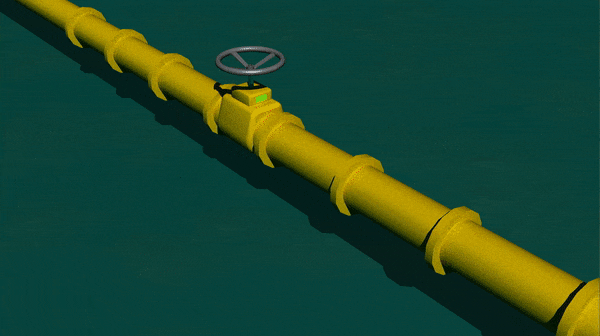
The future of Line 5: Engineering under Lake Michigan
How would Enbridge shut down the controversial pipeline and construct a replacement tunnel?

How would Enbridge shut down the controversial pipeline and construct a replacement tunnel?
As the deadline approaches for Canadian oil company Enbridge to shut down a 4.5-mile section of the Line 5 pipeline that runs beneath Lake Michigan, University of Michigan engineering researchers offered insights into how the company might go about doing that, and also how they might construct a tunnel under the lakebed for a replacement section of the line.
Michigan Governor Whitmer gave the company until May 12 to shut down the segment that runs along the Straits of Mackinac. Enbridge has filed a federal lawsuit challenging the order.

Authorities have been concerned about the pipeline’s age and issues with its protective coating for some time. But it was recent anchor strikes that knocked the underwater section off some of its supports that set the shutdown mandate in motion.
The fate of Line 5 is coming into focus at a pivotal time for the planet’s energy future. The Biden administration recently announced a goal to reduce greenhouse gas emissions by half by 2030. The U.K. also has a 2030 milestone for a ban on the sale of diesel- and gas-powered cars. Automakers are following suit. By 2040, GM plans for its entire operation to be carbon neutral, for example. This small section of pipe is a big, realtime case study on how complex our transition to more sustainable energy will be. International treaties, jobs, energy prices, environmental impacts and extreme engineering are all at play.
To state the obvious, an oil leak in the Great Lakes would be bad, which is why Enbridge is pursuing building a new tunnel to enclose its pipeline, while keeping a close eye on the Straits section.
As reported on the company website, Enbridge employees “monitor the Line 5 Straits crossing 24/7, using both specially trained staff and sophisticated computer monitoring systems. They also “carry out regular inspections of the line, using inline tools, expert divers, and remote operating vehicles (ROVs), going above and beyond regulatory requirements.”
But it hasn’t been enough, says Beth Wallace, a pipeline specialist and the Great Lakes Freshwater Campaigns Manager for the National Wildlife Federation.
“It’s important to note that they really only have a few months in a year to look at the physical pipeline because of weather conditions in that location,” says Wallace.
In 2020, Enbridge disclosed that when they were doing maintenance on the pipe, they discovered that one of the lines had moved.
“They realized that it was likely an anchor strike that hit the pipeline. And under further investigation, they learned that the other pipeline in that location, which is about a 1,000 feet apart, had also sustained damage—likely, from a different anchor strike. So there were two consecutive anchor strikes that were undetected by Enbridge,” Wallace says. Enbridge says it could also have been a cable dragging.
The Straits section was temporarily shut down to investigate the damage. Subsequently, the governor moved to revoke a 1953 state easement that allowed the Straits section to run along the lake floor. Whitmer gave Enbridge 180 days to comply, which landed on May 12. Enbridge filed a federal lawsuit challenging the order.
The battle over Enbridge’s easement is playing out in court, but regardless of the outcome, Enbridge may eventually shut down the Straits section. When the time comes, most of the process will be handled remotely. Enbridge controls the northernmost valve and the southernmost valve at the water crossing from a facility in Edmonton, Alberta.
“What’s important to note, though, is that when they last closed those valves to investigate possible anchor damage in the past, they did so with product in the pipeline,” says Wallace.
That is about 1.5 million gallons, or two Olympic-sized swimming pools, of oil that would be in limbo under the lake.
After some period of time, it will be in Enbridge’s interest to purge the stagnant oil from the pipeline—for the health of the pipe and the value of the product. At this stage a decommissioning process would likely begin. Enbridge describes its pipeline decommissioning process on its website. After the oil is pumped out of this section, the pipe is rinsed with water or other flushing products. Then a common pipeline inspection machine called a smart pig that fits snugly inside the pipe is fitted with scrubbers. The smart pig then drives itself through the pipe, cleaning as it goes.
“When it goes through a pipeline, it creates a really loud squeal noise, and that’s why they call it that,” says Wallace.

After the pipe is scrubbed, it is filled with an inert gas and routinely monitored. “In most cases leaving the line in place is less damaging to the environment than removing it,” says Ryan Duffy, Enbridge spokesperson.
If the Straits section were put into this decommissioned status, there could be implications for the rest of the line, up and downstream. How might Enbridge bridge the gap in Line 5 without the lake section? Enbridge maintains that Line 5 is safe to remain in operation while the company builds a tunnel beneath the lakebed to contain a new, replacement segment of pipeline.
The May 12 deadline does not prevent Enbridge from pursuing the tunnel option. That project is making its way through the permitting process, early steps in a lengthy construction timeline. So it’s unclear when the oil could start flowing through the line again, if it stops. What is clear is that building the tunnel would require some extreme engineering.
“Considered purely from a construction engineering perspective, this is a very exciting project in the sense that the methods themselves are comparable to other spectacular, global projects you might be familiar with, like the railway tunnel under the English Channel,” says Vineet Kamat professor of civil and environmental engineering at U-M.
Specializing in construction, automation and robotics, Kamat is familiar with the type of tunnel boring machinery Enbridge hopes to use. “Human experts are still in charge of what the tunnel boring machine does, but once it is set up and launched, then the process of carving out the tunnel, removing the muck and building the concrete lining proceeds in quite an automated fashion,” says Kamat. “So it wouldn’t be too far off to call it a semi-automated robot, except a very large robot.”

Enbridge’s current plans (which are subject to change) indicate that the boring machine will be roughly 500 feet long and will drill a tunnel that is 21 feet in diameter. The size of the tunnel is designed to enable safer containment and monitoring of the pipeline as well as house other utilities like fiber optic cable.
Enbridge plans to assemble the tunnel boring machine on the south side of the lake over the course of four months. Chewing through its projected 40 feet of rock each day, five days a week, it will take about two years to make its way across the Straits. At the north end, the machine would be dismantled and removed.
As the cutter head turns and tunneling progresses, a bentonite, or clay, slurry continuously applies pressure to the rock face for support, said Duffy, of Enbridge.
The machine lifts pre-cast one-foot-thick segments of concrete liner into place, inside its steel shield and applies grout to complete the seal.
“There is at no time any soil or rock exposed that could cave into the tunnel,” says Duffy. “During tunneling, the performance of the tunnel boring machine, slurry system, and tunnel lining will be instrumented and closely monitored to verify that systems are performing as anticipated.
“Properly designed and constructed, tunnels are inherently stable structures, in particular round tunnels.”
Duffy assured that the geology is suitable and the design and construction companies Enbridge is working with have built hundreds of tunnels in a wide range of ground conditions.
As the boring machine progresses, technicians will need to do periodic on-site inspection and maintenance deep underground.
“One might assume that once it’s underground, the tunnel goes more or less horizontally, but that is not the case,” says Kamat. “Rather, the deepest point of the tunnel approximately maps the deepest point of the channel as well. You may think of it as a shallow U-shaped vertical profile, which would be quite typical for a project like this.”
The tunnel will travel 60 to 250 feet below the lakebed, which is about 270 feet below the waterline. The depth of the tunnel will require those inspectors to live in pressure chambers on the surface for weeks at a time and be transported in a pressurized habitat.
While Enbridge estimates that the tunnel could be built in three to four years, the timelines for projects of this scale can be hard to predict.
“Every tunnel project is unique in terms of subsurface conditions, which is the biggest source of uncertainty,” says Kamat. “There could be issues with seepage of water in places where you would not expect it. There will always be differences between the properties of soil that are expected versus what is actually encountered. But, I don’t think those uncertainties are unsurmountable because this method has been used to construct many other larger projects of similar nature all over the world.”
Other non-engineering uncertainties surround this project, though. One of the main questions is what might happen with Line 5’s oil and current pipeline during the construction process.
Seymour Spence is an associate professor of civil engineering at U-M who specializes in assessing the reliability and integrity of structures. He uses computational modeling to determine the probability of collapse or inadequate structural performance. Several years ago he discussed with Enbridge the possibility of carrying out an integrity study to estimate the likelihood of the existing Line 5 Lake section failing in the next 10 to 20 years, he said. Evaluating infrastructure use past initial life expectancy is something civil engineers face more and more. In many cases, it makes sense to extend the lifespan with repairs and retrofits.
“We can’t imagine in any scenario that’s economically sustainable that we could replace every single piece of infrastructure we built 60 or 70 years ago because it came to the end of its forecasted life,” says Spence.
But in the case of Line 5, Spence was skeptical about the feasibility of such a study.
“Risk is defined by two parts,” he said, “consequences times probability of failure. Here the difficulty is that the consequences are very high. You’re not going to be able to reduce the probability of failure down to a level that, when multiplied by consequences, gives you a satisfactory risk.”
Spence felt that the existing pipeline’s age, extreme environment and other factors prevented the estimation of the failure probability with satisfactory confidence.
That said, the effects of a shutdown do need to be considered, says Seth Guikema, a U-M professor of industrial and operations engineering and co-founder of the Center for Risk Analysis Informed Decision Engineering.
“The consequences of pipeline failure could be quite dire, but that’s where the conversation generally stops. How likely is it? And what are the impacts of a shutdown? There is also a very real distributional issue. The people who bear the risks are not necessarily those who gain benefits from operating the pipeline.”
These questions about the current Straits section have many on edge.
The tunnel doesn’t pose the same concerns for risk researchers. And Enbridge is committed to pay all costs of the tunnel, currently estimated $500 million, which the company says would “virtually eliminate the chance of a pipeline incident in the Straits.”